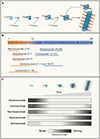Alzheimer's disease: From immunotherapy to immunoprevention
- PMID: 37729908
- PMCID: PMC10578497
- DOI: 10.1016/j.cell.2023.08.021
Alzheimer's disease: From immunotherapy to immunoprevention
Abstract
Recent Aβ-immunotherapy trials have yielded the first clear evidence that removing aggregated Aβ from the brains of symptomatic patients can slow the progression of Alzheimer's disease. The clinical benefit achieved in these trials has been modest, however, highlighting the need for both a deeper understanding of disease mechanisms and the importance of intervening early in the pathogenic cascade. An immunoprevention strategy for Alzheimer's disease is required that will integrate the findings from clinical trials with mechanistic insights from preclinical disease models to select promising antibodies, optimize the timing of intervention, identify early biomarkers, and mitigate potential side effects.
Keywords: ARIA; Tau; aducanumab; aduhelm; cerebral amyloid antipathy; dementia; donanemab; lecanemab; neurofilament; β-amyloid.
Copyright © 2023 Elsevier Inc. All rights reserved.
Conflict of interest statement
Declaration of interests The authors declare no competing interests.
Figures


References
Publication types
MeSH terms
Substances
Grants and funding
LinkOut - more resources
Full Text Sources
Medical

